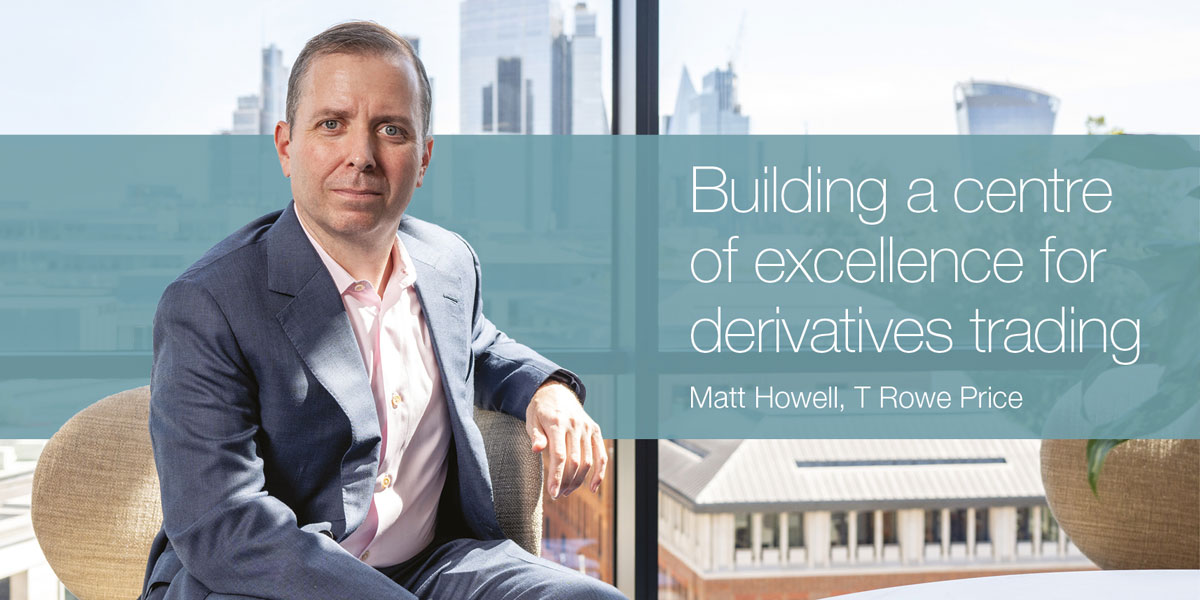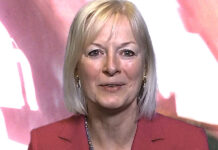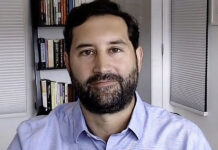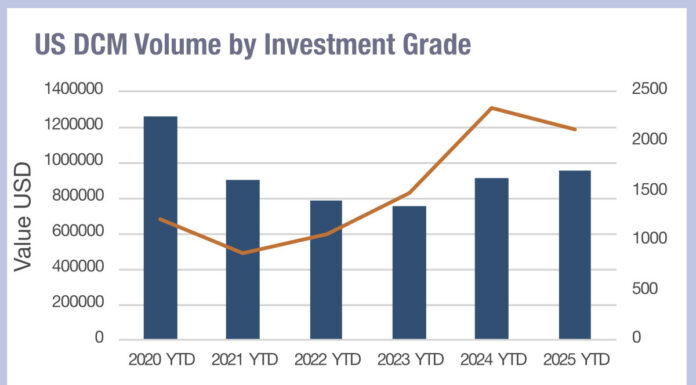Matt Howell reveals how T Rowe Price optimised its derivatives trading capabilities ahead of the expected boom in trading activity this year.
How are the competing offerings of credit futures and interest rate products from exchanges changing the way investors can express ideas into the market?
Credit futures could present an exciting opportunity to open up macro credit exposure to a wider set of accounts as well as offering the opportunity to trade or hedge tactically around positions in a more agile and efficient fashion. This could mean accounts that were unable to access macro credit through credit default swaps (CDS) or credit index swaps (iBoxx) can trade these exposures. They also potentially open up the market to more relative value trades and hence have the ability to potentially add or help transform liquidity.
The emphasis on short term interest rate products by exchanges tends to represent a change in market conditions versus a new product set; those products have always been there, but in a flat rates environment there simply was no trade. So, their use is reflecting the macro or central bank conditions.
Overall net, net the credit universe has more potential liquidity opportunities in it than it did before as a result of futures. Similar to what ETFs did for credit markets, historically, you’d have ETF market makers sitting on one side of the trading floor and credit desks sitting on the other, and they weren’t always talking to each other. Electronic market makers brought the desks together and now all the banks have built macro credit desks to manage risk and monitor liquidity with a unified team.
What is the interplay between listed and OTC derivatives today, and how are their uses changing?
Ever since the global financial crisis (GFC) there has been a big secular shift towards clearing a growing proportion of derivative activity. Some of this was driven by mandatory clearing and Uncleared Margin Rules (UMR) but we are also starting to see more voluntary clearing because of the funding benefits from a collateral perspective.
This has huge advantages in terms of managing counterparty risk and reducing collateral costs by offsetting exposures but it is not necessarily appropriate for all activity. There remain certain exposures that are very expensive to clear from a margin perspective or smaller transactions that are simply not cost efficient to clear as the funding can eat into any alpha. Understanding this dynamic up front via pre-trade analytics is important and presents an opportunity for development on the buy side.
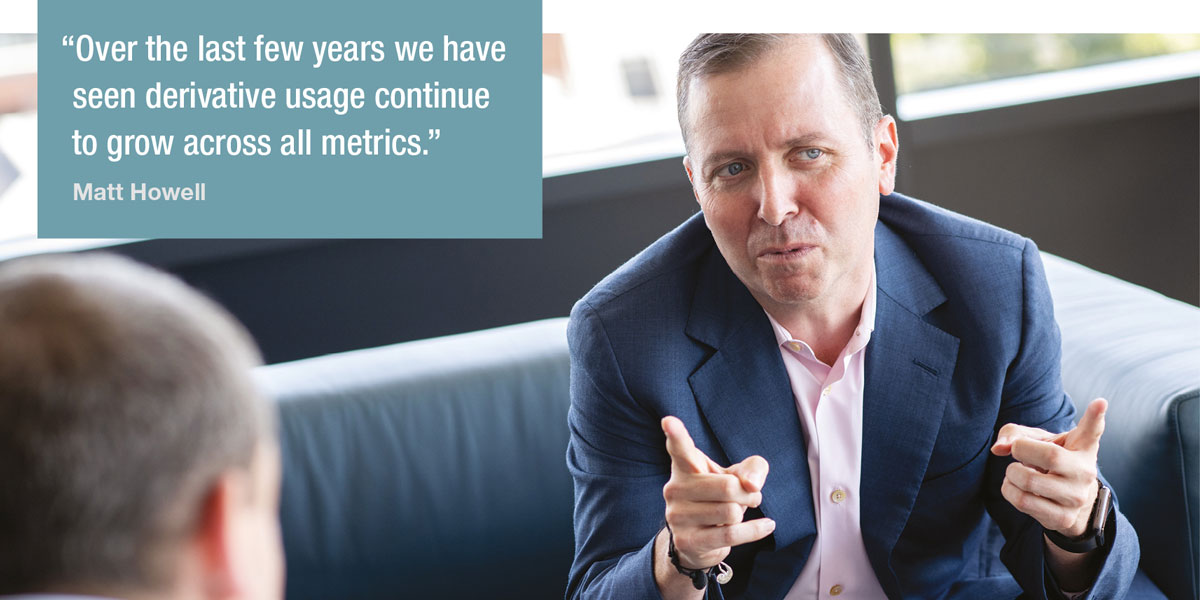
How have you developed T Rowe’s investment capabilities through engagement across cash and derivative products?
We spend a lot of time listening to the market and the investment team to carefully develop a prioritised list of new capabilities for implementation. Given the size and complexity of our business, including the variety of different investment vehicles we offer such as 40 Act funds, and UCITS funds, implementation of new capabilities can take a while. This means that we have to focus on forward-looking strategic capabilities rather than chasing tactical solutions for point in time opportunities or trades. For example, if a portfolio manager spots an opportunity that requires the positioning via a new instrument we cannot just onboard that, but if there is a strategic reason, it can make sense.
A good example would be inflation. We didn’t trade a lot of inflation up until a few years ago. The team looked at where the market was going, thought about the inflationary backdrop and saw a need to expand the suite of inflation products that we have on the platform, and that paid off. Equally interest rate optionality, we didn’t have a great range of instruments in that space, but lo and behold, that’s now much more of a live issue, and you want to have capability there.
Over the last few years we have seen derivative usage continue to grow across all metrics, notional traded, number of trades, diversity of instruments, portfolio managers using derivatives and number of accounts. As we add capabilities this opens up new internal customers for the capabilities we are building. One area of growth for us is an increasing comfort from the investment team in expressing ideas via macro products like exchange traded funds (ETFs) or other Index instruments. These open up new tools for our investment team.
Where do you see the greatest challenges to derivatives use coming from for investment managers?
At a large institutional asset manager there are lots of areas that present challenges for derivatives. Documentation is complex and time consuming, data is fragmented and requires careful stewardship and governance, and legacy technology was not always built with derivatives in mind. Moreover, standing up new derivative capabilities requires co-ordination across a wide range of teams across the platform; from legal to pricing/valuation.
What is the composition of the derivatives team at T Rowe Price, and how is leadership structured?
The derivatives team at T Rowe sits in global trading and acts as a centre of excellence for coordinating across the organisation. The team works on every stage of the lifecycle liaising with the other teams such as modelling, trading and middle office. We oversee the end-to-end process to ensure that derivatives work seamlessly through the stack, so we’re the ‘air traffic control’ for derivatives activity.
The team has a number of areas of expertise starting with implementation, who own the identification and implementation of new instruments, producing content and consulting with the investment team on optimal ways to express ideas.
They might engage with teams at the onset of implementing a new strategy, looking at what is possible, what index exposures can we take, are these futures liquid enough, how we will manage the margin, establish risk tools to oversee the Greeks, etc. Often, there are multiple ways to express investment ideas, so having a team that knows that it should be an option versus a future or a swap or an exchange-traded fund is a useful resource. We’re the experts on the variables that go into that decision.
It’s not just market variables, there is the product wrapper, the regulatory jurisdiction that impacts your collateral position, whether you’re in scope for UMR, all of these things go into the mix to determine how to express an idea.
The team also looks after derivative data. Ensuring accuracy of analytics, governing exposure calculations and generally being the point of contact for the wider business on all things derivative data related.
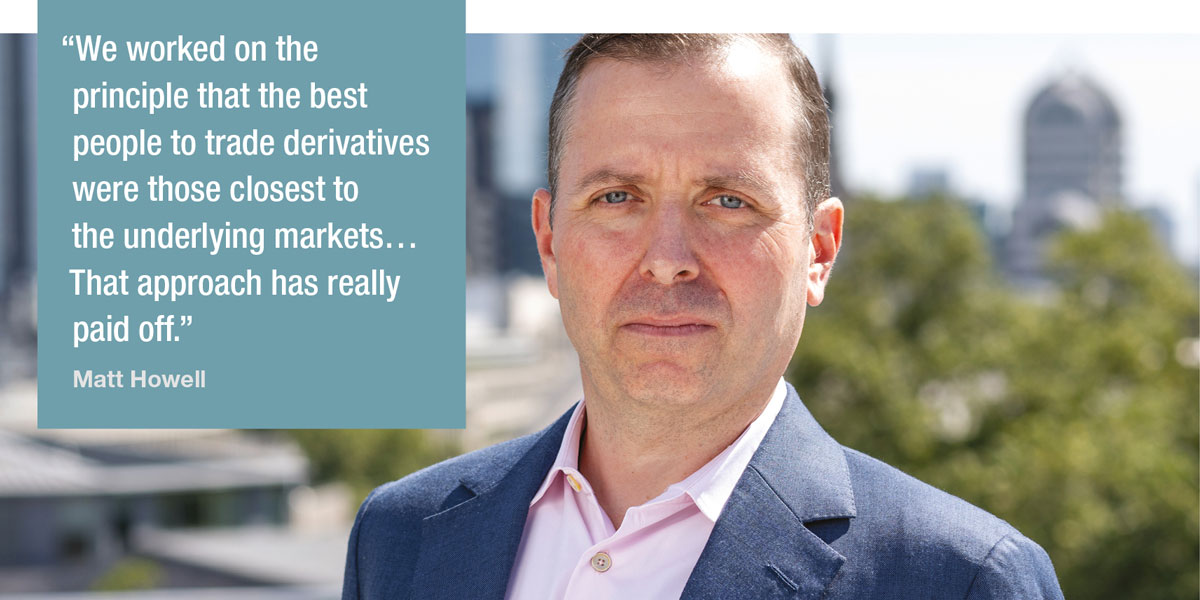
We are also focused on continually reviewing derivative workflows and looking for opportunities for process improvement. As utilisation patterns change sometimes there is some work required to ensure that a process scales appropriately and there are always opportunities to improve automation and connectivity. The other ongoing area of development is regulation. It’s the gift that keeps giving in derivatives and the team have successfully navigated a number of major changes over the last couple of years with UMR and the LIBOR transition to name two. We’re thinking proactively about being ready for them, so they don’t come in hot and heavy.
Finally, we are very focused on building out our funding solutions team. This group looks after collateral analytics, clearing relationships and optimisation, alongside our security lending programme. This is an exciting area for us as we continue to optimise in areas that have traditionally either not had the scale to need it or the flexibility to be able to implement.
I think it’s potentially a differentiating factor for what we’re doing at T Rowe. That team looks after collateral analytics, they own our clearing relationships and our clearing wallet. They think about optimisation for collateral and clearing but they also own our securities lending programme. We review exposures and suggest compression trades where applicable. All of those functions in that front office Treasury function let us optimise in areas that were traditionally either very operational or invisible to the investment team.
That’s a very interesting operational structure.
We were lucky to have that opportunity. As we stood up the team, the return on investment enabled us to get additional resources to expand responsibilities. We weren’t fighting a great deal of institutional structure, we were able to state that all of this belongs together.
How do you split skills across the team?
We have deliberately targeted a diverse range of skills, experience and background on the team from very experienced buy-side traders like myself and Tony Ives with a tonne of practical cross asset derivatives trading experience to those with a much more quantitative background who are comfortable with data manipulation and building out tools and reports for the rest of the organisation. The other key skillset we look for is communication. We are often dealing with a large number of stakeholders in a complex space. Open and transparent communication of these complex ideas, including education for the broader platform, is essential.
How are the profiles of derivatives traders evolving?
All of our traders are increasingly derivative literate. We made a conscious decision that, if we wanted to be able to scale, creating a separate desk or focusing expertise in a small number of individuals would lead to challenges. We worked on the principle that the best people to trade derivatives were those closest to the underlying markets. So instead we focused on education and support to ensure that the whole trading platform had somewhere they could go to ask questions and develop their understanding as we expanded in derivatives. That approach has really paid off. As we’ve grown our business substantially over the last few years, we haven’t encountered many issues from a scale point of view, and increasingly, our traders are comfortable in that domain.
What is your strategy to building a team for today and for the future?
The team is tasked with innovating and automating. If we can build the tools that allow the rest of the organisation to answer frequently asked questions independently then we have more capacity to work on new areas which keeps work varied and interesting. This means encouraging curiosity and creating the space for team members to bring new ideas to the table. It’s my hope that the team find that empowering and this helps everyone contribute. We’re keen on automating wherever appropriate and creating tools to enable stakeholders to “self-serve”.
We also offer a great career pathway to other areas in investments as we offer both the exposure and experience needed to take that next step. Some of the team may aspire to get closer to trading, other may seek portfolio management or risk management opportunities. We offer exposure to lots of different areas in the organisation, and if you have experience in the derivatives space the rest of it slots into place. We are an attractive destination for emerging talent at the firm and we have a tendency to pick people up fairly early in their career journey. Team culture is something we invest in a lot. We’re very diverse across a numberof different metrics, and then we’re geographically dispersed. Half the team is here, half the team is on the East Coast, so a regular cadence to daily standups with rotating chairs helps bring us together on a regular basis. We also identified a number of key team principles when we started that we review every year and reaffirm:
- Client First – By acting in the best interests of our clients we act in the best interests of T Rowe Price.
- Transparency – Working out loud wherever possible.
- Accountability – Proactively own derivative agenda at T Rowe Price.
- Technology’s Best Customer – Enabling them to help us is how we both succeed.
- Data Driven Decisions – Use data capture and metrics to improve decision making.
- Process Not Projects – Does this scale? Can we repeat it?
- Embrace Failure – Create space for reflection – always produce lessons learned.
- Questions Are How We Learn – Foster an environment that allows other voices to speak.
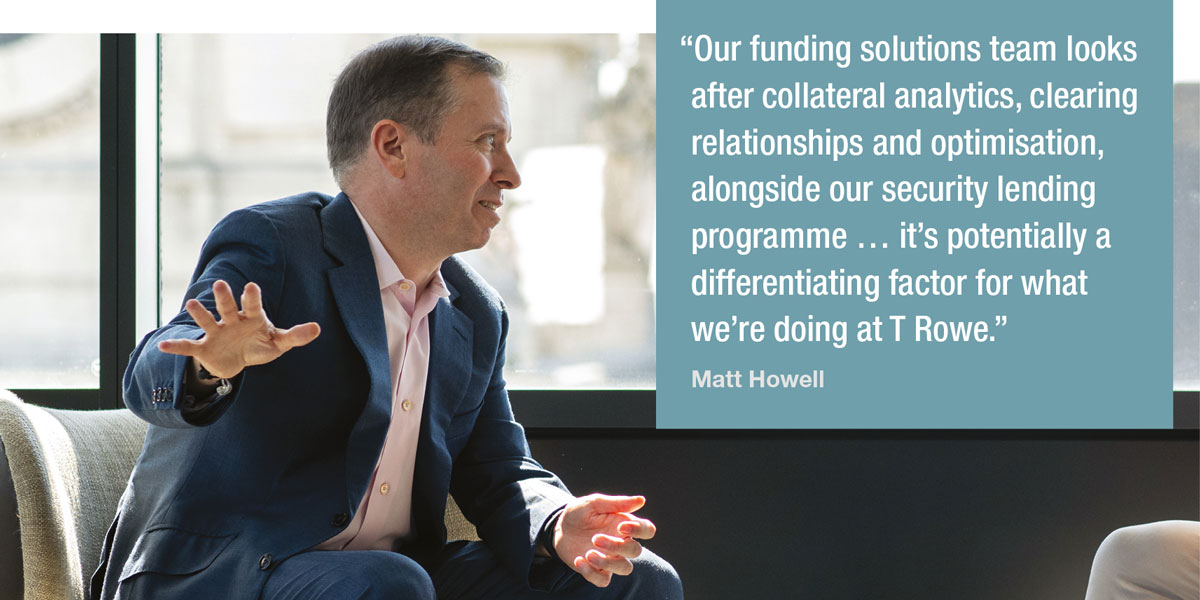
How do the derivatives traders manage voice vs e-trading?
We have traders covering cash and derivatives, so T Rowe has great coverage across trading in both voice and electronic. By their nature derivative counterparty lists are more concentrated than in cash for a variety of reasons but the advantage of co-locating our trading across cash and derivatives is that our relationships there strengthen one another and allow us to think holistically about counterparty relationships.
Electronic trading continues to grow in some derivatives classes such as futures, but there are clearly some areas where full automation is either not possible, not economical or not desirable. Understanding dealer appetite for risk and getting a sense for some of the other factors that go into pricing is critical for achieving best execution, particularly on our more high-touch flow.
Which technologies are must-haves on the desk, and why?
I don’t think we need to go over the necessity of the order management system (OMS) or how critical good execution management system (EMS) technology has become.
For derivatives our traders need to be able to manage their orders alongside cash products. If you are working delta or trading swaps you need to be able to see those orders alongside your business in the underlying to ensure you are keeping pace.
For OTC markets, solid request for quote (RFQ) technology is necessary and ideally this should cover a wide range of asset classes and products to simplify integration and workflow. Derivative trades need good quality and timely analytics both pre-trade and post-trade to be able to model ‘what ifs’ and also help manage lifecycle. These don’t just cover exposure and the Greeks but also inputs into collateral.
A key part of derivative trading is managing lifecycle events that you simply don’t have to deal with in regular cash markets. Be it managing futures rolls, compressing sways or dealing with option expiries, all of these require a different cut of data and traders need to be able to get this information in a timely fashion. We have built a number of tools internally on the desk that are a blend of dashboards and notifiers that aim to make that information available without having to navigate across multiple systems or maintain spreadsheets.
Given the multi-faceted aspects of structured products, how is risk managed and engaged with trading?
We don’t trade structured products to a great extent. I see structured products as being wrappers that are used to combine elements of other derivative products, where we use relatively vanilla derivative products.
However more broadly our risk teams covering business risk, counterparty and investment are always very engaged with trading. Be it alerts that might pop up on notional exposure or managing tolerances within accounts that might have thresholds coming from clients or regulatory thresholds for the fund wrapper we are using. Much of the work we have been doing around clearing and collateral optimisation is effectively an exercise in pro-active counterparty risk so this work is a direct positive for our counterparty risk team.
Which strategies are you seeing effectively delivered via derivatives this year?
There are a couple of more recent trends in the market that are grabbing a lot of the attention in the derivative space. In the US we have seen significant growth on ETFs using derivatives. Most notably to provide more income through overwriting but also leveraged ETFs and buffer ETFs. Overwriting is always an attractive strategy as it works to reduce drawdowns and provide some income at the cost of capping upside. The growth in these products has led to an every increasing supply of vol which has changed the face of equity volatility.
Another seismic shift in the US has been the shift to zero-day options (0DTE or zero days to expiry options). People used to trade using maturities of one month, three month and 1yr options, and, the way I think about it, when you do that you are effectively outsourcing your delta management for that period of time. As the market has got better at managing delta risk, they have been able to move down the maturity curve to zero day trading, reducing the need to outsource it.
This has shifted a vast amount of option activity to the very short end of the vol curve and again is changing the way that markets operate and most interestingly changing the nature of the VIX index, which for many years now has become the whole market’s proxy for equity volatility risk. Events over the last couple of weeks have raised questions over how valid that proxy is.
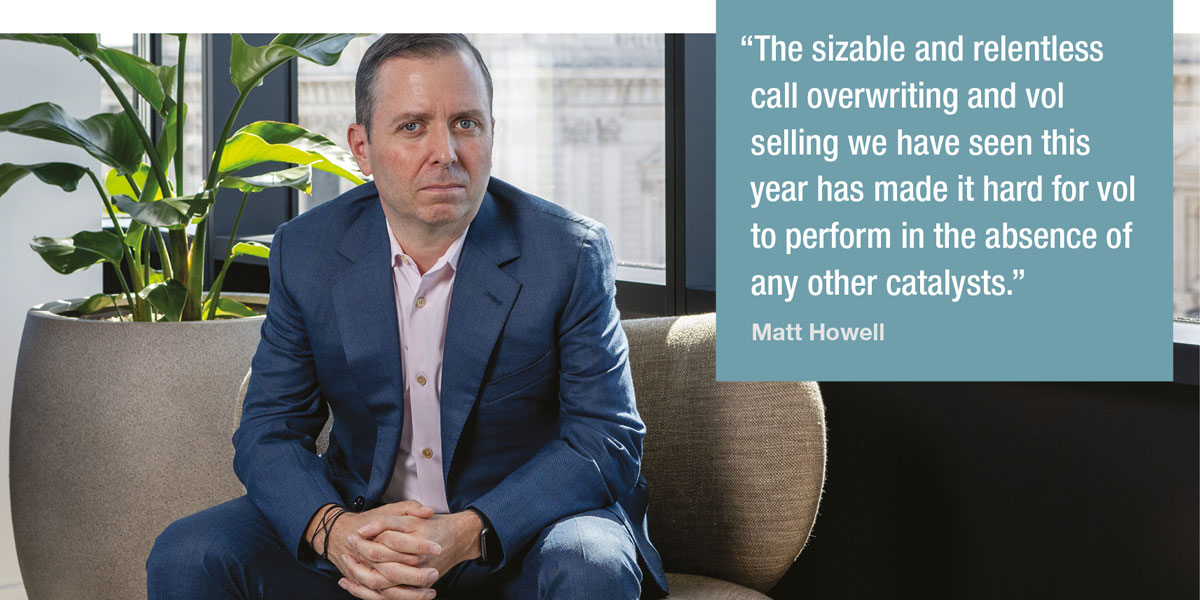
How do you see market conditions impacting instrument selection?
Market conditions are critical in instrument selection. You can have a great investment idea negatively impacted by poor implementation and there is nothing more frustrating than being right but not making the return you expected.
The level of implied volatility will always play a role in the use of optionality and whether it is more favourable to buy or sell options. The sizable and relentless call overwriting and vol selling we have seen this year has made it hard for vol to perform in the absence of any other catalysts. This low vol environment worked to increase the leverage used in a lot of strategies. These leveraged strategies being forced to de-risk can provide the catalyst for vol to outperform as we saw with recent events post-Bank of Japan (BOJ) and centred around the JPY carry trade. The resulting sell-offs push the strikes of sold options far enough out of the money (OTM) that dealers are no longer massively long gamma, and markets are less pinned, allowing for larger moves, particularly when liquidity in some of the underlying instruments becomes constrained.
In this respect instrument selection or implementation can actually end up affecting market conditions.
Elsewhere, uncertainty in economic data, either upside or downside surprises can create dramatic shifts in short term rate expectations. This can see short term interest rate products like SOFR futures come into play as a way of expressing views on the Fed, for example.
FX as ever is a relative game so will always be looking for divergence in growth or central bank paths across currencies.
Which macro dynamics are having the greatest impact on your activity?
I think these are the same for all markets. The interplay between growth and inflation and the global central banks’ reaction function remains a key determinate. Politics is also playing a role and we could see that climax in November with the US election, after a record year for elections around the globe. One thing that seems to be constantly there for markets these days are the larger geopolitical considerations that can bring the potential of an outsized move, however these are always very hard to predict, let alone trade.
What is your approach to handling potential volatility for the rest of 2024?
We have to work on the assumption that vol supply will continue to be a feature. Only 10 days this year have seen net outflows from the US call overwriting ETFs and this means that dealers will remain long gamma and keep realised vol pinned. The key will be, like earlier this month, looking for when leverage and positioning get pushed to extremes and managing vol risk accordingly.
This dynamic does create opportunities to take advantage of high/low extreme levels of vol skew if you have a view. Year to date we’ve seen cheap risk reversals in equity and credit driven by low vol and very low skews for the level of vol.
©Markets Media Europe 2025

